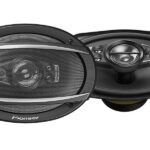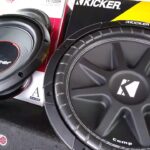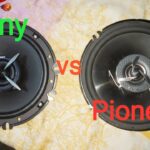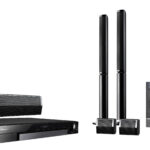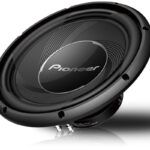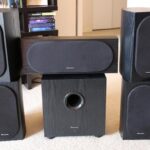A mono amplifier is a device that amplifies audio signals using a single channel. A mono amplifier is a single-channel device that boosts audio signals, making them louder and more powerful.
It is commonly used in audio systems to improve the quality and volume of sound output. By amplifying the signal without adding any distortion or noise, the mono amplifier enhances the overall listening experience. Whether used in car audio systems, home theaters, or professional sound setups, a mono amplifier plays a crucial role in delivering clear and robust audio.
With its ability to channel and amplify the audio signals effectively, the mono amplifier is a valuable component in any audio setup.
Understanding Mono Amplifiers
A mono amplifier, also known as a monoblock amplifier, is a type of audio amplifier that is designed to power a single channel or speaker. Unlike stereo amplifiers which have two channels to power two speakers, mono amplifiers have a single channel which allows for more power to be delivered to a single speaker.
Mono amplifiers are commonly used in professional audio systems, car audio systems, and home theater systems. They are often preferred for powering subwoofers due to their ability to provide a more focused and powerful sound.
One of the main differences between mono amplifiers and stereo amplifiers is the number of channels. While stereo amplifiers have two channels for left and right speakers, mono amplifiers have only one channel. This allows mono amplifiers to provide more power, resulting in increased audio performance.
Using a mono amplifier in your audio system can offer several benefits. First, it allows for greater control and precision in sound reproduction, particularly in low-frequency ranges. Additionally, mono amplifiers have a lower distortion level and can drive speakers more efficiently, resulting in improved sound quality.
| Benefits of using a mono amplifier | Definition and purpose of a mono amplifier | How mono amplifiers differ from stereo amplifiers |
|---|---|---|
| – Greater control and precision in sound reproduction | – A type of audio amplifier for powering a single channel or speaker | – Mono amplifiers have one channel, while stereo amplifiers have two channels |
| – Improved sound quality and lower distortion | – Used in professional audio systems, car audio systems, and home theater systems | – Mono amplifiers provide more power to a single speaker |
| – Efficiently drives speakers, particularly in low-frequency ranges | – Preferred for powering subwoofers |
Key Features Of Mono Amplifiers
Key Features of Mono Amplifiers:
- Power output and efficiency: Mono amplifiers are known for their ability to deliver high power output and excellent efficiency. They can easily drive large speakers and provide a clean and powerful audio experience.
- Signal-to-noise ratio: Mono amplifiers have a high signal-to-noise ratio, ensuring that the audio signal is clear and free from any background noise or distortion. This is crucial for an immersive listening experience.
- Input and output options: Mono amplifiers offer various input and output options, allowing you to connect them to a wide range of audio sources and speakers. Whether it’s RCA, XLR, or speaker-level inputs, mono amplifiers provide flexibility in connectivity.
- Amplification technology used: Mono amplifiers utilize different amplification technologies such as Class AB or Class D. Class AB amplifiers provide a balance between power and sound quality, while Class D amplifiers offer higher efficiency and compact size.
How Mono Amplifiers Work
What is a Mono Amplifier
A mono amplifier, also known as a monoblock amplifier, is a type of audio amplifier that is designed to amplify a single audio channel or signal. Unlike stereo amplifiers, which handle two audio channels, mono amplifiers focus on a single channel, allowing for greater power output and efficiency.
Amplification process and signal flow
Mono amplifiers use a straightforward amplification process to boost the signal from the audio source. The audio signal passes through the amplifier circuitry, including components such as transistors or tubes, which increase the voltage and current. This amplified electrical signal then flows into the speaker, converting it back into an audible sound.
Components and circuitry
A typical mono amplifier consists of various components such as capacitor networks, resistors, transistors or tubes, power supply units, and input/output connectors. These components work together within the circuitry to amplify the incoming audio signal and provide the necessary power output to the speaker.
Impact on audio quality
Mono amplifiers are known for their ability to deliver high-quality audio performance. By focusing on a single audio channel, mono amplifiers can provide a more accurate and detailed sound representation. The dedicated amplification also helps in reducing distortion and noise, resulting in a cleaner and more immersive audio experience.
Common misconceptions and myths
There are a few misconceptions and myths surrounding mono amplifiers. One common misconception is that mono amplifiers are only suitable for specific music genres or audio setups. However, mono amplifiers can be utilized in various applications where powerful and accurate amplification is required, including home audio systems, car audio setups, and professional audio setups.
Choosing The Right Mono Amplifier
When selecting a mono amplifier for your audio system, there are several important factors to consider.
Determining the power requirements for your speakers is crucial. Make sure to **match the power output of the amplifier to the power handling capacity of your speakers** to ensure optimal performance.
Matching impedance and sensitivity is also vital. **Ensure that the amplifier’s impedance matches that of your speakers**, and consider the sensitivity level to achieve the desired volume.
Don’t forget to think about **system compatibility and possible future upgrades**. Ensure that the amplifier is compatible with your current audio setup and can accommodate any potential upgrades down the line.
Finally, **take budget considerations and brand reputation into account**. Research different models, read reviews, and compare prices to make an informed decision.
| Factors to Consider | Recommendations |
|---|---|
| Power Requirements | Match amplifier power output to speaker power handling capacity |
| Impedance and Sensitivity | Ensure impedance compatibility and consider sensitivity for desired volume |
| System Compatibility | Check compatibility with current audio setup and potential future upgrades |
| Budget and Brand Reputation | Research, read reviews, and compare prices from reputable brands |
In conclusion, choosing the right mono amplifier involves considering power requirements, impedance, sensitivity, system compatibility, and budget. By carefully evaluating these factors, you can make an informed decision that enhances your audio experience.
Installation And Setup Basics
A mono amplifier is a device that amplifies a single audio channel, typically used in car audio systems or home theater setups. Installation and setup of a mono amplifier require a few basic steps to ensure proper functionality and optimal performance.
Connecting the mono amplifier to audio sources and speakers is the first step in the installation process. It involves using appropriate cables to establish a connection between the amplifier and the audio sources such as a head unit or a preamp, as well as the speakers. Proper grounding and cable management techniques should be employed to minimize electrical interference and ensure reliable connections.
Once the connections are made, adjusting the gain and volume levels is crucial to achieving the desired sound output. Gain control determines the amplifier’s input sensitivity, while volume control regulates the overall loudness. Both need to be carefully adjusted to avoid distortion or damage to the speakers or amplifier.
In addition to the audio setup, positioning and optimizing speaker placement contribute to the overall sound quality. Experimenting with speaker placement and room acoustics can help achieve the best possible audio experience.
Getting The Most Out Of Your Mono Amplifier
When it comes to getting the most out of your mono amplifier, there are several key features and considerations to keep in mind. Utilizing features like bass boost and frequency filters can help enhance the overall audio performance and tailor it to your preferences. Another option to explore is bi-amping and bridging, which allows you to further optimize the amplifier’s power delivery for different types of speakers.
Room acoustics and speaker placement play a crucial role in maximizing the performance of your mono amplifier. Taking the time to properly position your speakers and account for room reflections can significantly improve the overall sound quality and imaging. Additionally, considering the maintenance and troubleshooting tips for your mono amplifier can help prolong its lifespan and address any potential issues that may arise.
Common Applications Of Mono Amplifiers
A mono amplifier, also known as a monoblock amplifier, is a type of audio amplifier that amplifies a single audio channel or signal. It is commonly used in various applications, including home audio systems, car audio systems, professional sound setups, and live performances and theaters.
For home audio systems, a mono amplifier can be used to power a subwoofer or a dedicated center channel speaker, providing enhanced bass and clear dialogue. In car audio systems, a mono amplifier is often used to power a subwoofer, delivering deep and powerful bass output. In professional sound setups, mono amplifiers are essential for driving large speakers and ensuring maximum sound quality and clarity. And in live performances and theaters, mono amplifiers are used to amplify the sound signal for various audio equipment, including microphones and instruments.
Ultimately, mono amplifiers play a crucial role in enhancing audio performance and providing high-quality sound reproduction in a range of applications.
The Future Of Mono Amplifiers
A mono amplifier, also known as a monoblock amplifier, is an essential component in audio systems, designed to amplify a single audio channel. With advancements in amplifier technologies, mono amplifiers have evolved to meet the changing needs of the audio industry and consumers.
Integration with Wireless and Smart Home Systems
The integration of mono amplifiers with wireless and smart home systems has revolutionized the way we experience audio. With wireless capabilities, these amplifiers allow for seamless connectivity and control, enabling users to stream music from their smartphones or tablets. Additionally, with compatibility with smart home systems, users can integrate their mono amplifiers into their existing setups, creating a synchronized audio experience throughout their homes.
Potential Impact on Audio Industry and Consumer Experience
These advancements have the potential to significantly impact the audio industry. Manufacturers are now focusing on creating mono amplifiers that offer high fidelity, efficient power delivery, and customization options to cater to the discerning needs of audiophiles. As a result, consumers can expect enhanced audio quality, increased convenience, and flexibility in their listening experiences.
Conclusion
To summarize, a mono amplifier is a single-channel amplifier that is capable of providing maximum power output to a single speaker. It plays a crucial role in enhancing the audio experience by delivering clear and powerful sound. Whether you are a casual listener or an audio enthusiast, a mono amplifier can greatly improve your audio system.
Understanding its features and benefits will help you make an informed decision when it comes to choosing the right amplifier for your needs.
Frequently Asked Questions Of What Is A Mono Amplifier
What Is A Mono Amplifier?
A mono amplifier, also known as a monoblock amplifier, is an audio amplifier that is designed to power a single channel or speaker. It provides a single channel of amplification, typically used for powering a subwoofer or a single speaker in a car audio system.
Mono amplifiers are known for their high power output and low distortion, making them popular in car audio enthusiasts and professionals.
How Does A Mono Amplifier Work?
A mono amplifier works by taking a low-level audio signal and amplifying it to a higher power level suitable for driving a single speaker or subwoofer. It utilizes electronic components such as transistors or integrated circuits to increase the voltage and current of the signal.
The amplified signal is then sent to the speaker, producing louder and clearer sound reproduction.
What Are The Advantages Of Using A Mono Amplifier?
Using a mono amplifier offers several advantages. Firstly, it allows for precise power delivery to a single speaker or subwoofer, ensuring optimal performance. Additionally, mono amplifiers often have higher power output compared to multi-channel amplifiers, making them ideal for systems that require a lot of power.
They also tend to have lower distortion levels, resulting in cleaner and more accurate audio reproduction.
Can A Mono Amplifier Be Used For Multiple Speakers?
No, a mono amplifier is designed to power a single speaker or subwoofer. It is not suitable for driving multiple speakers simultaneously. If you need to power multiple speakers, you will need a multi-channel amplifier or a separate mono amplifier for each speaker.

